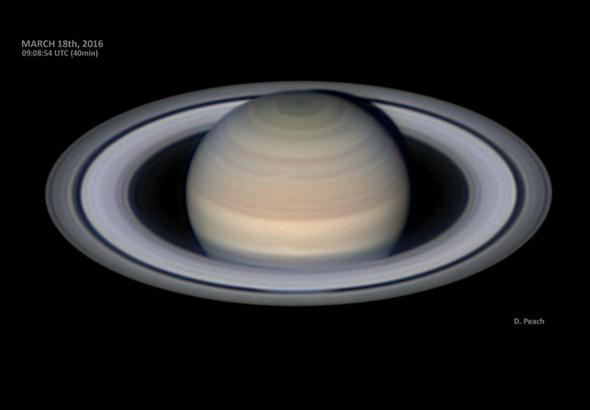Another day, another weird Facebook astronomy hoax.
The photo with the caption above have been spread around Facebook quite a bit the past few days; it shows Saturn looming huge in the sky over a city, with the annotation, “On 5/1/16 Saturn will be the closest it ever has been to Earth. It will look like this.”
I got a few notes from readers on Twitter about it. Unlike a lot of other wrong but possibly sincere memes, this one is clearly a hoax. It’s just silly and wrong on every level, so it couldn’t possibly have just been an honest mistake. It’s a joke.
What’s wrong with it? Well, two main things: Saturn isn’t the closest it’s ever been on May 1 (its closest approach to Earth this year is in June), and Saturn can’t get big enough to look like that, ever. Which is a good thing.
The closest Saturn ever gets to Earth is about 1.2 billion kilometers. That’s something of a hike. Saturn is big—120,000 kilometers in diameter, not including the rings, which are 250,000 kilometers across—but from that distance it’s not even big enough to appear as a disk to the eye. Through binoculars you can see the rings as a tiny ellipse, and through a smallish ‘scope you can more clearly see the planet as a disk and the rings circling it.
To be that big, Saturn would have to get as close to us as our Moon! In fact, that’s where the image comes from. It was easy enough to track down; a reverse image search on Google showed it’s from a Russian video intended to show what the sky would look like if the Moon were replaced with the other planets in our solar system:
It’s a fanciful idea, and as far as I can tell first done by my pal Ron Miller, a space artist, in 2012, and again by videographer Yeti Dynamics in 2013. In fact, Yeti Dynamics went ever further and created a wonderful video showing what it would look like if Saturn were actually passing the Earth in the solar system:
As I wrote at the time, that would be the most amazing sight ever witnessed … and also the last thing you’d see. From that distance, Saturn’s gravity would inflict monstrous tidal forces on the Earth, causing apocalyptic floods, massive earthquakes, and generally dealing out death on a global scale.
As much as I love looking at Saturn, I’m pretty happy it’s more than a billion klicks away.
So where is Saturn right now? It’s currently about 1.37 billion kilometers away, where it always is. It rises around 10:30 p.m. local time, and shines at a magnitude of about 0.2, making it one of the brightest objects in the sky. In fact, it’s very much worth going out and taking a look around midnight; very close to it in the sky is the much brighter and much oranger Mars, and the bright red supergiant star Antares, the heart of Scorpius. Face south and look low to the horizon for the trio; your outstretched fist can cover all three.

Damian Peach
And if you have a telescope, well then what are you waiting for? Saturn is one of the most magnificent objects in the sky. Patience pays off, too: In early June it will be at opposition, opposite the Sun in the sky, which means it rises at sunset and is up all night. As an added bonus, that’s when it truly is closest to the Earth, and appears as big as it can. But then, that means it’ll be 0.3 arcminutes across: Only 1/100th the width of the Moon in the sky.
But through a telescope, it’s glorious. So forget the dumb Facebook hoaxes, and go see the real Universe for yourself. It’s way, way better.
